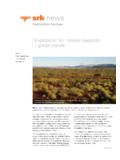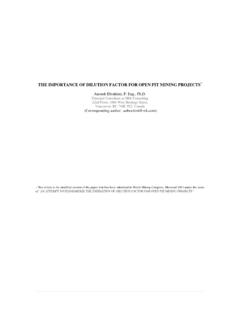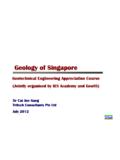Transcription of Open Pits Going Underground - SRK
1 1 But many of these pits are in, or will be Going into, very good ground. This creates major challenges for the operators: should they opt for a pre-break, like sublevel cav-ing, at considerable additional cost? Or go for natural caving, and fight the resultant coarse fragmentation? The jury is still out, and probably will remain so at least until the results from the envelope-pushing Palabora caving opera-tion are known. This South African mine epitomises the major challenges for caving, remarks SRK s Chris Page. Firstly, achieving a cave and, secondly, efficiently handling the coarse fragmentation. The International Caving Group has con-sidered many of the challenges and also some of the solutions. However, none of the answers are Going to be easy.
2 A whole range of issues, from pre-conditioning to cave stimulation, present some very chal-lenging situations. However, the cost efficiencies achieved at Northparkes mine, and the success that recent sublevel caves have achieved in Australia do give some reason to be confident. Open Pits Going UndergroundOpen pit Going Underground A critical issue, Chris points out, will be achievement of the levels of control taken for granted in an open pit. Tele-remote technology and specialised communica-tions systems will make this possible, he observes. The industry is almost there. It just needs some brave souls to embrace the concepts. But, he cautions, cave mining in the future is Going to require a totally different way of operating, both technically and managerially, if it is to compete with open pit efficiencies.
3 Chris PageSome of the world s major mining companies, currently comfortably mining from large efficient open pits, are looking into the future when these pits come to an end. To maintain a competitive position on the cost curve, these organisations will have to take open pit efficiencies Underground . Only caving methods can challenge open pit 28 SRK s InternationalNewsletter Focus on Caving Section through proposed skouries open pit and cave mine2 MRMR modelling for Skouries gold/copper projectBlock caving combined with open pit mining and sub-level caving will be employed at the proposed Skouries gold/copper mine in Halkadiki, north-east Greece, owned by SRK client commissioned SRK to integrate geotechnical data gathering with the exploration drilling programme at the pre-feasibility stage.
4 This ensured the project had an excellent coverage of geotechnical information and that a full geotechnical model as comprehensive as the geo-logical and resource model could be produced. At the pre-feasibility stage, the mining rock mass rating (MRMR) model was critical in selecting the optimum min-ing is a classic pipe shaped porphy-ry. Mining is proposed by open pit down to 200 m then by sub-level and by block caving at depths to around 1000 m. Two main rock types are present: a relatively weak sheared argillaceous schist and a very strong quartz porphyry. The open pit and the cave mining will intersect both of these lithologies and will therefore encoun-ter significantly different mining conditions.
5 Collection of suf-ficient geotechnical data at the exploration stage of a project can be vital to its optimum design, says SRK Cardiff managing direc-tor and principal geotechnical engineer, Allan McCracken. The fact that SRK and TVX integrated the assay and geotechnical data collection at the pre-feasibility stage meant the programme was cost effective. Drilling solely for geotechnical purposes was avoided and an excellent database was obtained. This proved to be very im-portant in the subsequent modelling and design studies. The data was evaluated using the MRMR system, with adjustment factors to model the different mining conditions in the open pit and cave. A 3D block model of the ge-ology and MRMR was created by weight-ing techniques in the GEMCOM PC-MINE software.
6 The circular nature of the pipe required that hoop stress factors were used which have the potential to raise the MRMR and hence require greater under-cut areas to induce Skouries project is scheduled to follow TVX s other nearby Olympias gold mine project into McCrackenSRK Consultant Profile: Geoff BullGeoff Bull s mining career started in the caves at Shabanie Mine in 1968. Since then he has accrued experience in pro-duction, technical planning, project management and rock mechanics in Underground mining. In numer-ous operations, in Zimbabwe and South Africa, he worked up through the ranks from learner mine official to General Man-ager. He served as rock mechanics engineer for Roodepoort Durban Deep Gold Mine in South Africa and Shabanie Mine in Zimbabwe, and for five years prior to moving to Australia, Geoff was director of his own company in Zimbabwe providing mining, rock engi-neering and blasting consultancy services.
7 Geoff joined the SRK team in Perth, Australia in 1998 as a Principal Mining Engineer. He provides specialized consult-ing services in block caving and sub-level caving methods. More recently he has been involved in block cave and sub level cave studies for Newcrest s Ridgeway and Telfer Projects, operational and study reviews for Northparkes block cave, a block cave assessment for Olympic Dam, due diligence review of the Didipio block cave (Philippines), and operational reviews and improvement programmes for the sub level caves at WMC s Leinster Nickel Operations and Copper Mines of Tas-maina s Mt Lyle is also currently serving as a con-sultant to the International Caving Study Stage 2, specifically involved in aspects relating to flow characteristics of broken rock and draw control.
8 SRK s aim is to participate in initiatives directed towards improving the effectiveness and efficien-cies of caving methods says Geoff, and in encouraging those who desire to push the limits in caving the lower grade, stronger, deeper and more challenging ore bodies. Geoff Bull3 Technical auditing of block caving projectsSRK recently undertook a technical audit of a major block caving project, partly aimed at verifying that the proposed block cave production tonnages are achievable. SRK s Richard Butcher recalls the audit was complicated by the fact that the client required confirmation inside a month that cave production tonnages were achievable. In terms of production rate, says Richard, auditing experience has shown that a number of factors can adversely affect the ability of a block cave to achieve target production tonnages.
9 Factors include incorrect selection of block caving strategies and lack of design detail for both the undercut and draw horizons. Other issues include the selection and use of unrealistic parameters in project production schedules (for instance, designing production tonnages for a hard rock block cave based on mature draw rates immediately after undercutting), and lack of cave management strategies related to draw control, undercut lag control and so on. Taking cognisance of these factors, SRK devised the audit method shown above, whereby the general design rationale was scrutinised for strategy correctness and design detail. In addition, production parameters were inspected for correctness. The guiding principle behind the audit was that if the caving strategies, designs and design inputs were correct/realistic, then production tonnages were achievable, Richard CAVE PROJECTED PRODUCTION RATES ACHIEVEDCAVE MANAGEMENT STRATEGIES IN PLACE * DRAW CONTROL* POINT LOAD CONTROL* "BLACK HAT" ON STRATEGIESAREA MUST BE UNDERCUTACCORDING TO PRODUCTIONGENERAL UNDERCUTAREA ORE PRODUCTIONSYSTEM GENERAL BLOCK CAVEDESIGN DRAW (HORIZON)
10 LAYOUT DRAW HORIZON PRODUCTION PARAMETERSDRAW HORIZON DEVELOPMENT RATESDRAWPOINT CAPACITYDRAWPOINT PRODUCTIONPROFILE REQUIRED NOS DRAWPOINTSOPEN FOR TARGET TONNES NORMAL OPERATIONALRESTRICTIONS ON DRAWPOINTUNDERCUTEXTRACTIONRATES UNDERCUTDEVELOPMENTRATES UNDERCUT ADVANCERATES UNDERCUT TONS/CAVE TONS BALANCEUNDERCUT SEQUENCEUNDERCUTMETHODOLOGYUNDERCUT PRODUCTIONPARAMETERS Flow diagram to show factors that affect the annual production rate from block cavesRichard Butcher4 Chris PageAfter assisting Newcrest with the design and evalua-tion of the sub-level caving method (SLC) for the Ridgeway project, and providing ongoing senior review, SRK is privileged to be part of Newcrest s reali-zation of their vision of an Underground ore factory.










